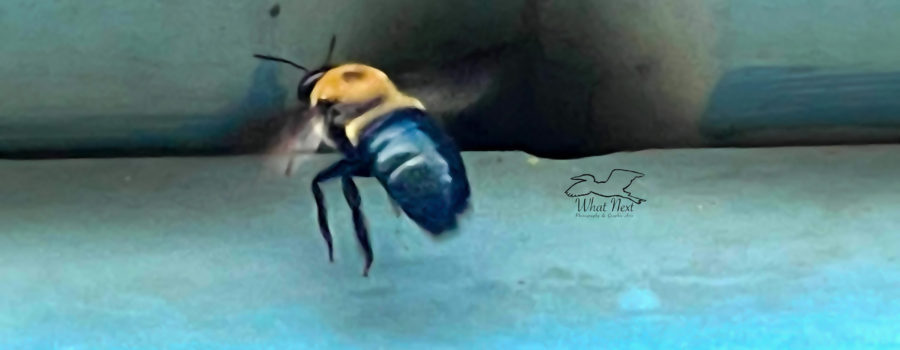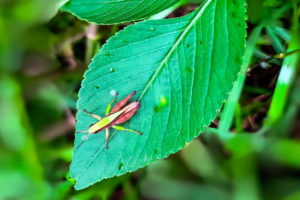Carpenter Bees are Scary, but Harmless and Very Helpful

Every spring, as things start to warm up and the spring wildflowers begin to bloom, the bees, wasps, and other pollinators also start to come out of hibernation and become active feeding, pollinating, and nesting. One of the most noticable bees is the large eastern carpenter bee (Xylocopa virginica). These bees are good sized (similar in size to bumble bees, but with a hairless abdomen), tend to hover around nesting and feeding sites, and make a loud buzzing sound, all of which can bring them to our attention. Male carpenter bees especially have been called ”aggressive” by unknowing people since it is common for them to hover around anyone or anything that wanders into their sight. When they hover around your head and face, it can be scary and perhaps a little intimidating, but please don’t be frightened. It is not an aggressive behavior, but rather a curious behavior. These bees find mates by visual cues, so they are curious about anything that moves. If you toss a small object away from you most of the time the male bees will follow it and leave you alone. Also realize that male carpenter bees are unable to harm you since they have no stingers. Females are capable of stinging, but rarely do unless swatted or handled.

There are actually two general types of carpenter bees, large carpenter bees and small carpenter bees. The large carpenter bees are some of the largest bees in the world, and usually nest in dead, but not rotting wood. Small carpenter bees are considerably smaller and usually build their nests in the stems of smaller shrubs and plants. In Florida, we have two species of each type of carpenter bee, but there are hundreds of species throughout the world that nest in various trees and plants. All carpenter bees have several things in common, though. They are all considered solitary bees, meaning that they do not form hives or colonies like social bees do, and they all build tunnel-like nests in plants or trees. Regardless of the species, these nests are separated into cells. Each cell is supplied with food and a single egg is laid. Most nests consist of 6-8 cells. The nests are guarded by the female bees, and in some species the adult female may share her nest with her daughters for a period of time. Being solitary bees, these species do not have a single reproductive female or queen like social bees do. Instead, all females reproduce and rear their own offspring. Carpenter bees also have a considerably longer lifespan than social bees. Carpenter bees can often live to be 2-3 years old, whereas most social bees live only a single reproductive season, and often not even that long depending on their caste.

Besides being scary, large carpenter bees like Xylocopa virginica have developed a bad reputation because they can cause structural damage to homes, fences, and other wooden structures. Fortunately, most of the time the damage is minimal, and the best way to avoid it is to keep wooden structures painted, since carpenter bees don’t usually nest in painted wood. They don’t damage the trees that they nest in since they only choose dead wood for nesting sites. Carpenter bees are very good pollinators for many kinds of open faced flowers, and like bumble bees they are “buzz pollinators”, so they are crucial for pollinating certain types of flowers, including the maypop (Passiflora incarnata) and certain species of Orphium flowers. They also pollinate many other wildflowers such as asters, false indigo, tickseeds, spurge, blackjack, and milkworts to name just a few. Carpenter bees are also excellent pollinators for many vegetables including tomatoes, eggplant, blueberries, peas, and cranberries. Finally, it should be noted that carpenter bees can help to increase yields of many commercial crops by up to 15% depending on the plant and the area.

In summary, like so much of the world, the carpenter bee has both good qualities and bad. I personally don’t mind being buzzed by the curious, but harmless male, but I do understand how many people would. I had to learn to be calm around bees and wasps, especially since I do have allergies (luckily, not life threatening ones) to their stings. I also understand people not wanting nests built in parts of their homes and fences. On the other hand, we need to remember that for the most part we can keep them from nesting in our important structures simply by keeping those structures painted. And it is important that we also take into account all the good that they do. In the long run the good far outweighs the little bit of annoyance that they cause us.






Recent Comments